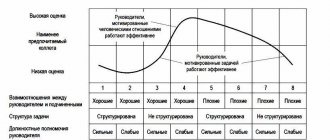How do you communicate with employees? Do you powerfully control every step, let everything take its course, practice an individual approach? So how does it work? Today we will talk about leadership styles. Make yourself comfortable, let's begin!
Or maybe you haven’t thought about leadership style at all? Business is going well, the online store is developing, why complicate things? Let's look at the main management styles and the pros and cons of each. This will help you understand the strengths and weaknesses of your leadership and determine what style to pursue in the future.
What is an authoritarian leadership style
It is believed that the method of sole leadership with the establishment of strict discipline is an authoritarian leadership style. Its main principle is absolute authority, the primacy of the leader. Authoritarianism is based on the ability to make quick decisions, on clear and clear orders, without allowing objections, as well as on the denial of any manifestations of initiative on the part of subordinates. This leadership style is considered effective in cases where the organization has reached a crisis in labor discipline. However, this particular management style is considered dangerous due to the occurrence of staff turnover.
In pedagogy
The preference for authoritarian leadership among teachers increases the external performance of their work. Such statistics can be traced to the achievement of a high level of discipline and student achievement.
However, this pedagogical approach has disadvantages - the socio-psychological atmosphere of such a class is unfavorable, since the student simply does not have the right to express his own opinion. Any initiative coming from a student is perceived by an authoritarian teacher as an act of self-will, which is unacceptable for the latter. Suppression of a student's will has a detrimental effect on his further socio-psychological development.
In personnel management
Management and personnel management is the area in which the authoritarian management method is most often used. In order to increase the efficiency of the work process and streamline the provoking behavior of employees, a decision is made to apply a directive style. Thus, the boss himself is responsible for the progress of work, excluding delegation of his powers in any form. An authoritarian leader gives clear instructions that staff members are obliged to follow unquestioningly.
Note! There are known cases when a manager abused power, which led the organization into decline - employees left their positions, as a result of which the activities of the organization as a whole suffered.
Sometimes managers abuse their power
What should be the management style of a company at different stages of its existence?
If you fail at work, enthusiasm disappears, and burnout at work is possible. Self-confidence comes and goes. What is needed is a boss with a supportive management style.
It is important for an employee to receive support, praise, and to know that his opinion is listened to. And the ability to make decisions independently raises the employee’s self-esteem and motivates him to solve new problems.
Capable and determined “I can and I want.” Experience and knowledge at the highest level. The employee solves the task with ease. Motivated, confident.
Management styles On the other hand, there are tendencies to restrain individual initiative and one-way movement of information flows from top to bottom, and there is no necessary feedback. The use of an authoritarian style, although it ensures high labor productivity, does not create the internal interest of performers in effective work.
Advantages and disadvantages of such management
Styles of pedagogical communication and their brief characteristics
One of the main advantages of this management style is the effective behavior of the leader. The advantage of an authoritarian leader is that he is aware of the level of his responsibility and in problematic, even crisis cases, he is able to quickly navigate and make certain decisions in the shortest possible time. It happens that companies in decline decide to accept help by hiring an authoritarian leader as head. Undoubtedly, any existing democracy ceases to function, since the new leader assumes the only goal - to raise the company and achieves it, first of all, through strict control over the implementation of work according to instructions.
Naturally, it is not without its drawbacks. First of all, the psychology of modern man in the era of freedom of speech and action is not capable of working in conditions of an authoritarian attitude, which a manager can achieve through insults and belittlement of an employee’s professional qualities. In this case, staff turnover may occur, resulting in the constant departure of employees. At the same time, newcomers do not have time to get used to it, gain experience, and either they are fired or they leave on their own. Sooner or later, given this state of affairs, the company will cease to exist.
Method results
Alas, the authoritarian method of education always has negative consequences, sometimes quite severe. A child who lives and grows up in fear is deprived of the joys of childhood and is unlikely to become a happy, healthy and fulfilling person in the future.
As a child, he experiences awe and fear of his parents, but by adolescence the situation changes, and fear is transformed into hatred, aggression, and withdrawal. Constant and quite strong conflicts arise, the teenager becomes uncontrollable, dreams of leaving home as soon as possible.
Often, authoritarianism in the family leads to the child becoming despotic and cruel. He takes out his pain, grievances and fears on the weaker. He can mock animals, offend children at school, and become a hooligan.
A child raised in an authoritarian regime does not know what compromises or peaceful resolution of conflicts are, does not know true friendship, is not inclined to love others, and does not know pity (because he did not receive this in the family). Such a child is convinced that the one who is stronger is right, he gets everything by brute force, behaves cynically, rudely and cruelly.
Another scenario is the development of a weak personality. The child does not have his own desires, does not feel the right to get what he wants, he is lacking initiative and only knows how to follow orders. This person is deprived of his own will, he has extremely low self-esteem and lacks self-esteem, he considers himself weaker than others. Of course, such a person will not be able to achieve real development, success and prosperity in life.
Basic mistakes
Types of communication in psychology - what they include, its functions
The authoritarian leadership style is a tool that is advisable to use for a limited time, otherwise the authoritarian leader may cross the line by feeling the power and beginning to abuse it. Given that the authoritarian style does not allow for the usual friendly conversations with subordinates, many managers often forget themselves, and instead of giving the usual order, they resort to sharp criticism, including insults and humiliation. In this leadership style, rewards are also not welcome, but punishments for disobedience or incorrect execution of orders may take on an inadequate form.
An authoritarian leader bears great responsibility
An authoritarian leader is a person with a huge amount of responsibility. It is unacceptable to neglect this responsibility, as well as to attempt to assign it to subordinates. However, in the pursuit of productivity, some managers may lose self-control, taking out their anger for existing failures, missed deadlines, etc. on employees. The only thing this will lead to is the loss of employees one after another, which clearly will not benefit the organization. It is one thing to punish or fire an employee for insubordination. Another is to intimidate him so that other team members decide to leave their jobs, deprived of motivation and faith in the positive results of hard work.
Employee efficiency
Efficiency should not be confused with effectiveness.
A result is a completed action that is measured in specific units. Employee performance is important for both managers and business owners. Employees exchange their performance for salary.
Efficiency includes the methods and resources by which results are achieved. An employee’s effectiveness is determined by two components: professionalism and loyalty to the company. Professionalism includes the knowledge, skills, experience and competencies of an employee. Loyalty shows how involved an employee is in his work, whether he is results-oriented, and how motivated he is to achieve results for the benefit of the company.
If we measure professionalism and loyalty on a 10-point scale, then the employee’s effectiveness will be determined by the lowest score on one of them.
For example, a professional salesperson sells from the first call and exceeds plans (9 points on the professionalism scale), but he is not very interested in what will happen to the company (3 points on the loyalty scale). Its effectiveness will be 3 out of 10. A similar picture will be in the case of a super loyal employee who is willing to work on weekends and wear a T-shirt with the company logo, but at the same time does not understand the product he is selling and does not know how to talk to the client. He will be as effective for the company as he can sell.
A competent manager determines the personal effectiveness of each employee, chooses which management style is most effective for him and improves his weaknesses.
When is it effective?
Human resource management - what it is, principles and functions of the process
There are a number of reasons why it is necessary to adopt an authoritarian leadership style. Among them, there are periods in an enterprise when the discipline of employees decreases, and along with it, the financial indicators of the organization itself and its income decrease. An autocratic director is required in order to improve the work of the team, albeit by taking tough measures. In extreme cases, the weakest links will leave their positions, and other employees will be hired to fill them. With characteristic management, an organization in decline will soon regain its previous position and strive for progress.
Note! Employees who have experienced a change in leadership style should remember that this is a temporary phenomenon. With maximum patience, obedience and skills, each team member will be able to become part of that historical moment when the organization emerges from the crisis.
general characteristics
In the modern world it is not so common because the idea of equality and support prevails. This allows you to unlock the potential of employees, inspire them to achieve and, in general, motivate them to work. In the Soviet Union, authoritarianism was very popular in various enterprises. People of that time had few opportunities for development, and most did not even think about their vocation.
There are such varieties:
- Dictatorial - the manager makes decisions, and his subordinates strictly follow them. But not because of trust in a significant figure, but due to existing sanctions and punishments.
- Autocratic - characterized by the power of the apparatus of power, which is simply limitless.
- Bureaucratic - the use of outdated, sometimes ineffective management techniques in work. The authority of the boss is formal.
- Patriarchal - subordinates treat the director as a father figure. They are ready to follow him and voluntarily obey.
- Benevolent - the manager enjoys authority due to the fact that he treats his team more kindly than with other types of management.
Examples of authoritarian leadership type
One of the clearest positive examples of authoritarian leaders is Henry Ford. He was so careful in selecting employees that he literally studied all their ins and outs. Focus on structural details, efficient and thoughtful work allowed him to found a world-famous company.
Another example belongs to another automobile company, which was in crisis for some time. In the end, a specialist was invited who managed to combine authoritarian and democratic governance. As a result, this commonality of management orientations helped the company reach the global level.
Chrysler management combined democratic and authoritarian management styles
The authoritarian leadership style is characterized as contradictory. Many people consider this style to be cruel, since the opinions, experience and skills of subordinates are not taken into account. On the other hand, there are many examples where this type of government pulled organizations out of decline. One way or another, it has its place among managers; it is often resorted to in cases where the company is exposed to a crisis.
At what stage of task implementation is a directive management style required?
- How to choose a personnel management style: characteristics of styles and methods
- Management styles
- Directive (authoritarian) management style
- Authoritarian management style (directive)
- Situational Leadership
- Leadership style
- What should be the management style of a company at different stages of its existence?
- Team management style
How to choose a personnel management style: characteristics of styles and methods A boss or mentor is suitable for such an employee.
An employee needs control and setting clear goals, but somewhere he needs to encourage, suggest, explain, then the employee will have motivation and desire. Capable, but not determined “I can, but I don’t want to.” The employee has sufficient professional knowledge
Attention: I have experience. Motivation disappears
What are the strengths and weaknesses of the democratic style?
| Powers | Weaknesses |
|
|
This style is applicable in conditions of formation and growth of an enterprise with a fairly stable team. It is very useful in situations of crisis in the internal environment of the company, when problems arise in relationships and work processes.
Types of DSR, their comparison
Democratic style has two types:
- advisory;
- participative.
Each of them is characterized by its own set of conditions for organizing work.
Advisory
The boss, trusting his employees, consults with his subordinates before making decisions or setting tasks. In the process of such communication, the manager selects the best and most valuable proposals. Based on them, tasks are formed. With this approach, employees receive satisfaction from the fact that they can support their boss and point him in the right direction. As a result, no one is bothered by the fact that instructions come from above. Good offers are usually followed by encouragement.
Advisory type of DSR
Participative
This democratic type of leadership is built on the fact that the boss does not consult, but completely delegates the consideration of assigned tasks to the group, ensuring the involvement of all interested employees for constructive proposals. They are also entrusted with control over the fulfillment of the formed goal.
Participative type of DSR











